Imaging Proteins at the Single Molecule Level.
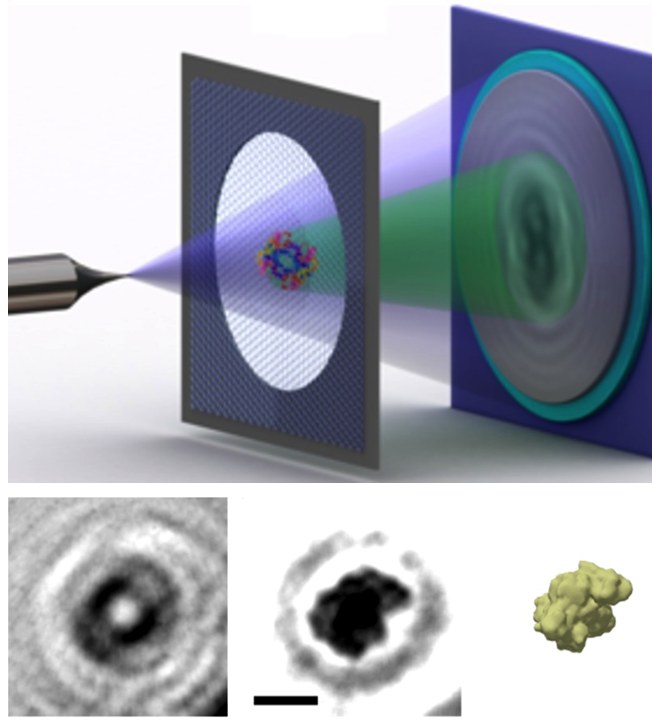
In this work we demonstrate the imaging of individual proteins and protein complexes by low-energy electron holography. This is made possible by producing ultrapure samples of ultraclean freestanding graphene onto which individual, chemically selected molecules were prepared by soft-landing electrospray ion beam deposition, a preparation method which is chemical- and conformational specific and allows for a gentle deposition. Low-energy electrons do not induce radiation damage, which enables acquiring subnanometer resolution images which are not the result of an averaging process.
Proc. Natl. Acad. Sci. U.S.A., DOI:10.1073/pnas.1614519114 (2017)
Article
Molecular Nanostructurs through Two-Dimensional Folding of Polypeptides at Surfaces.
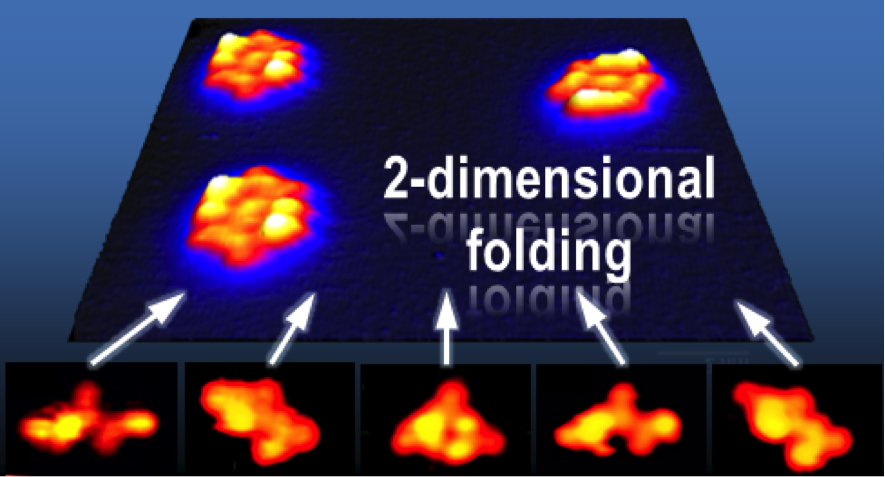
Folding is nature’s powerful tool for crafting highly functional, yet adaptable protein structures from an amino acid sequence. The final structure including high specific interaction sites as well as the folding pathway are already encoded in this sequence. Here, we demonstrate the fabrication of molecular nanostructures via two-dimensional folding of a nine amino acid peptide on a surface in vacuum. We observe the variability of the peptides conformation as well as a uniform folded state with subnanometer resolution using scanning tunneling microscopy. By an in depth theoretical analysis based on a unique combination of DFT and MD simulations we gain a detailed understanding of the mechanism, revealing similarities and differences to the folding in a native, aqueous environment.
ACS Nano, DOI: 10.1021/acsnano.6b06145 (2017)
Article
Correlation Driven Transport Asymmetries Through Coupled Spins in a Tunnel Junction
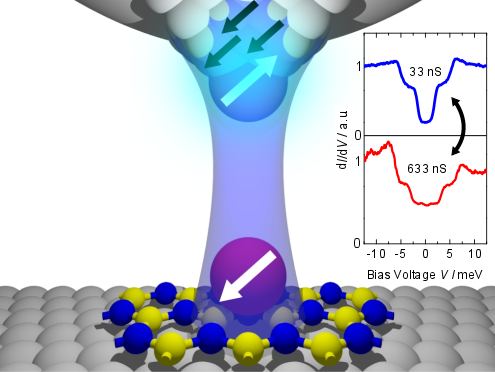
Spin–spin correlations are fundamental to many material properties because they favour certain ground states and are key in numerous models that describe the behaviour of strongly correlated materials. While the sum of collective correlations usually lead to a macroscopically measurable change in properties, a direct quantification of correlations in atomic scale systems is difficult. Using a scanning tunnelling microscope we now determined the correlations between a localized spin and its electron bath by observing the appearance of differential conductance asymmetries during the coupling to a second spin in the junction.
Nature Communications 8, 14119 (2017)
Article
Sensing the quantum limit in scanning tunnelling spectroscopy.
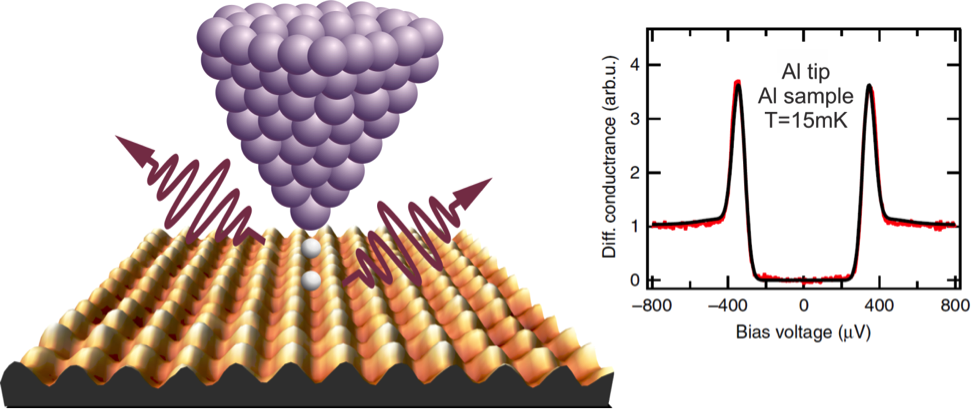
What would happen if an electric current no longer flowed, but trickled instead? This was the question we recently investigated. It involved cooling our scanning tunnelling microscope down to fifteen Millikelvin. At these extremely low temperatures, the electrons reveal their quantum nature. The electric current is therefore a granular medium, consisting of individual particles. The electrons trickle through a conductor like grains of sand in an hourglass, a phenomenon that can be explained with the aid of quantum electrodynamics.
Nature Communications 7, 13009 (2016)
Article
Driving the Oxygen Evolution Reaction by Nonlinear Cooperativity in Bimetallic Coordination Catalysts
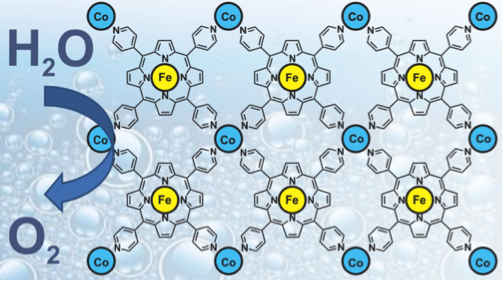
The oxygen evolution reaction is the limiting factor of the water splitting reaction. Developing efficient catalysts for the demanding four electron reaction is one of the prominent challenges in today’s energy conversion technologies. Here, we report porphyrin-based heterobimetallic-organic network inspired by metalloproteins and single atom electrocatalysts that show a dramatic enhancement in oxygen production by nearly two orders of magnitude compared to monometallic porphyrins. Non-linear increasing catalytic activity is facilitated through the electronic coupling of the catalytically active metal centers through the extended π-system of the molecules. This step forward towards efficient oxygen reduction catalysts using earth abundant materials is highlighted in Nature Energy
J. Am. Chem. Soc., 138 (11), pp 3623–3626, (2016)
Article
Coherent spin tunneling in molecular magnet-graphene hybrids
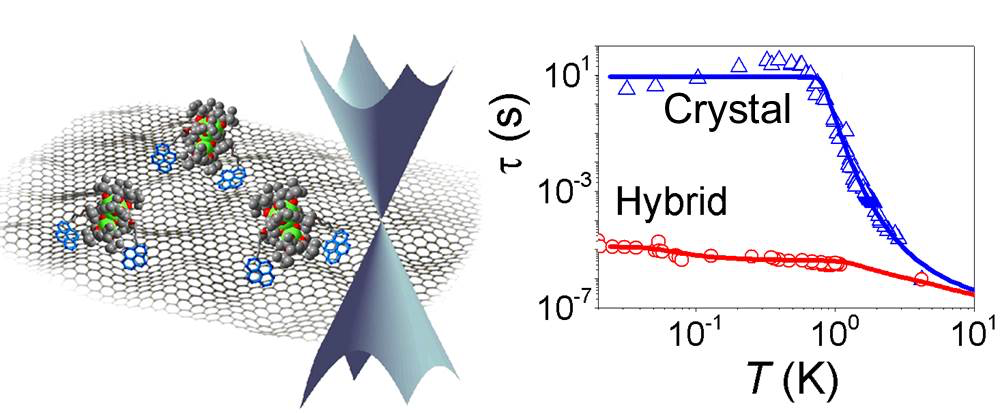
Understanding the dynamics of spins on surfaces is of great importance for the design of devices that exploit novel means of spin manipulation. One attractive strategy involves the use of graphene for the electrical manipulation of close-by spins. To this end, we have studied the classical and quantum spin dynamics of molecular magnets on an underlying graphene substrate. While the presence of graphene leaves the static spin response of the molecules unaffected, their quantum spin dynamics and the associated selection rules are strongly altered. Theoretical modeling reveals that coupling of the molecular spins to the Dirac electrons of graphene enables a fully coherent, resonant spin tunneling process.
Nature Materials 15, 164 (2016)
Article
Two-Dimensional Honeycomb Network through Sequence-Controlled Self-Assembly of Oligopeptides
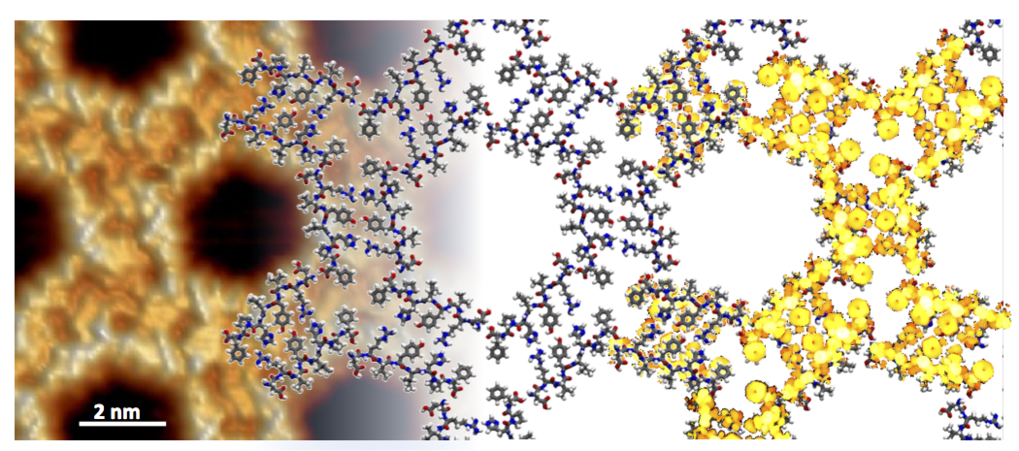
In nature, the blueprint for function and shape of proteins and peptides is inherently comprised in the amino-acid sequence. Thus, manipulating the sequence changes the assembly of these biomolecules. In this work, we demonstrate that it is possible to use this sequence control to steer the surface confined assembly of peptides: we manipulate the bond motifs to yield a porous honeycomb network of peptides on the surface. Despite the flexibility of the building blocks, the network is long-ranged ordered and highly fault-tolerant. Our approach demonstrates the potential of the vast sequence space to build different 2D peptide structures and functional surfaces.
Nature Communications 7, 10335 (2016)
Article
Quantum Engineering of Spin and Anisotropy in Magnetic Molecular Junctions
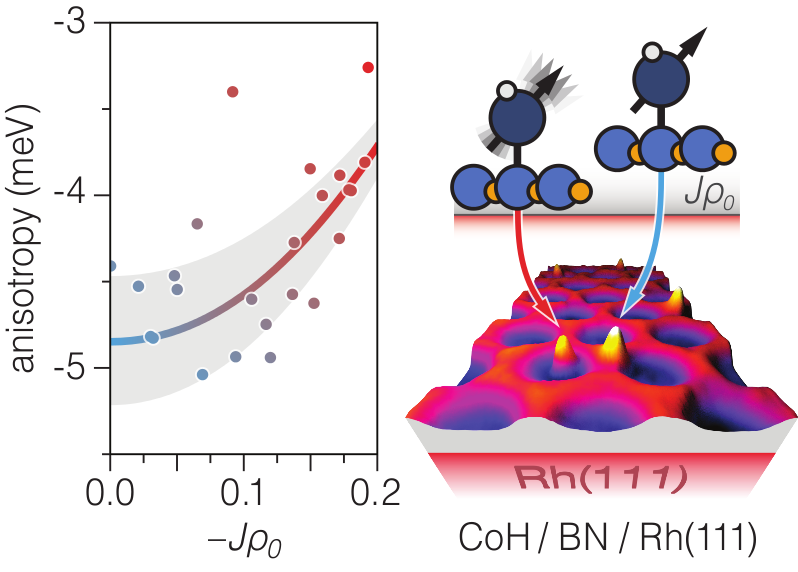
Single spins can be individually addressed when coupled to contacts forming an electrical junction. The chemical environment and local symmetry largely define the magnetic anisotropy. However, magnetic anisotropy also depends upon how the spin couples to the conduction electron bath via Kondo exchange. Here, we utilize a highly corrugated hexagonal boron nitride monolayer to mediate the coupling between a spin and the metal contact. Our experiments demonstrate how the Kondo exchange interaction mimics chemical tailoring and changes the magnetic anisotropy.
Nature Communications 6, 8536 (2015)
Article
Exciton dynamics of C60-based single-photon emitters explored by Hanbury Brown–Twiss scanning tunnelling microscopy
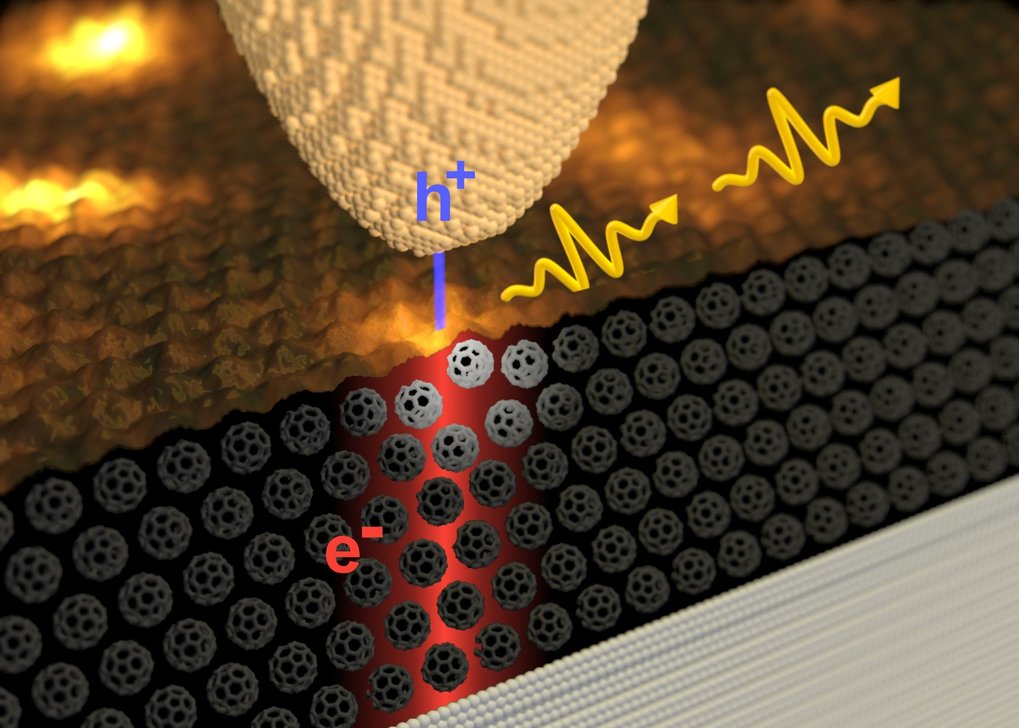
The creation of excitons and their annihilation are crucial processes in the energy conversion between electric circuits and light, e.g. in light sources and solar cells. We recently measured the dynamics of excitons by combining electroluminescence in the scanning tunneling microscope and Hanbury Brown-Twiss interferometry. The measured temporal correlation between photons created at structural defects of solid C60 reveals single photon emission and allows to determine an exciton lifetime of 0.75ns. For increasing current the lifetime reduces strongly proving that excitons are efficiently quenched by passing charge carriers. Our experiment introduces a unique way to study exciton dynamics and exciton-charge interaction employing current injection with ultimate molecular precision.
Nature Communications 6, 8461 (2015)
Article
Tuning the isoelectric point of graphene by electrochemical functionalization
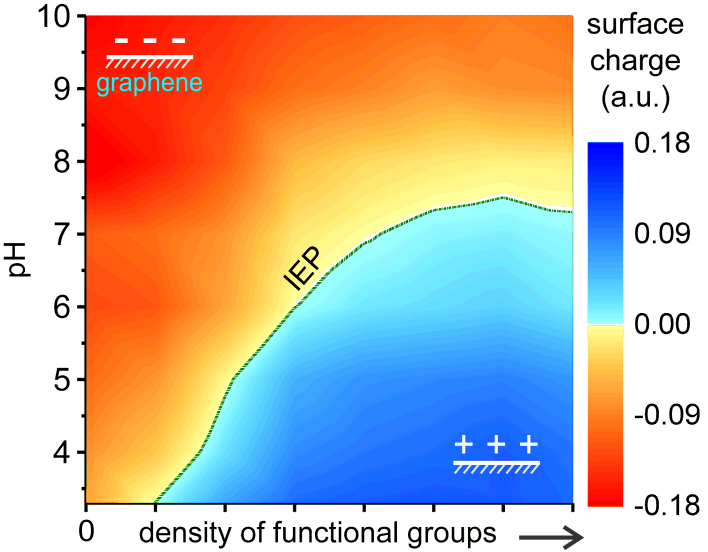
The surface charge behavior of the solid-liquid interface as governed by the isoelectric point plays a crucial role in the resulting physico-chemical properties. The pI is a key parameter which needs to be controlled for realizing applications in catalysis, sensing and energy conversion. For the first time, we present here a way to identify the isoelectric point of bare graphene and estimate it to be less than 3.3. Through controlled attachment of aromatic amino groups (by electrochemical modification of graphene) and supported by elaborate theory we unambiguously show that the pI of graphene can be continuously tuned from up to 7.5.
Scientific Reports 5, 11794 (2015)
Article
Local vibrational fingerprinting of chemical functionalization on single nanotubes and graphene
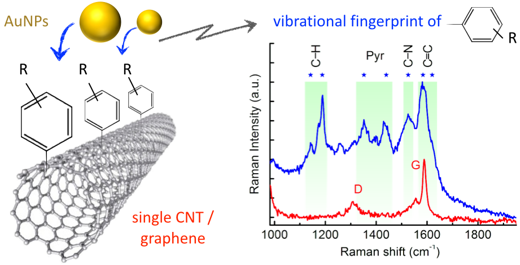
Chemical functionalization of nanostructures allows for realizing materials and systems with novel physical and chemical properties. One important challenge is the need for obtaining chemical information about attached functional groups at a single object level. Here we present a new kind of tool called local vibrational fingerprinting which enables mesoscopic identification of chemical groups attached to individual carbon nanotubes or monolayer graphene. Moreover, we quantify the relative proportions of different functionalities with diffraction-limited spatial resolution. The method is generic and simple, can be applied to other kinds of nanostructures and can be carried out using just a confocal Raman microscope without the need for more specialized instruments.
ACS Nano 9, 3314 (2015)
Article
Chemical Modification of Graphene via Hyperthermal Molecular Ion Beams
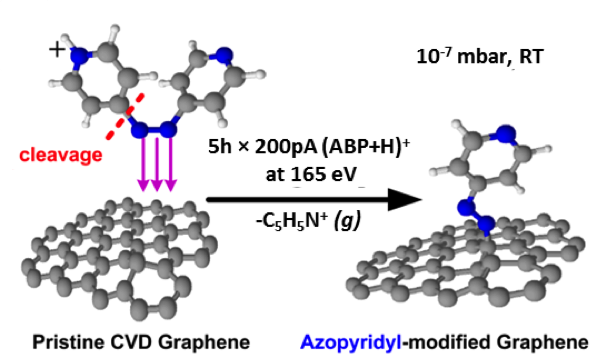
A wide range of device applications of graphene rely upon suitable methods for tailoring its electronic properties. Along these lines, band gap opening in graphene has been achieved via covalent chemical modification of its basal plane. We have developed a novel approach to chemically functionalize graphene in covalent manner, involving the use of hyperthermal molecular cation beams of 4,4’-azobis(pyridine) in electrospray ion beam deposition (ES-IBD). The one-step, room temperature ion-surface reaction process takes place in high vacuum (10-7 mbar) above a threshold kinetic energy of 165 eV of the molecular ions. Covalently linked azopyridine moieties are obtained with a functionalization degree of 3% of the carbon atoms of graphene after 3-5 hours of ion exposure of 2⋅1014 azopyridinium/cm 2 of which 50% bind covalently. This method is highly promising for the patterned functionalization of extended graphene areas under conditions compatible with state-of-the-art device fabrication technologies
J. Am. Chem. Soc. 136, 13482 (2014)
Article
A fast light emitting transistor of molecular dimension
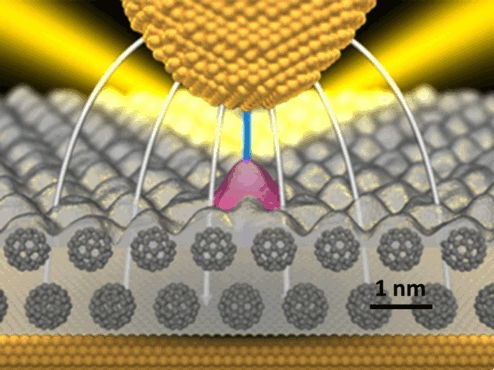
Optical communication requires the fast conversion of electronic signals to light pulses. We realized an electro-optical interface for this purpose on the ultimate scale of a few nanometers. The signal conversion takes place in a tunnel junction between two metal electrodes with a single decoupled molecule in the middle. The molecule operates as a sensitive and fast transistor. A millivolt modulation of the molecules’ potential is converted to plasmonic light emission with an on/off ratio of several orders of magnitude. The emitted light follows the voltage modulation in less than a nanosecond.
Nano Lett. 14, 5693 (2014)
Article
First atomic-scale insights into dye-sensitized solar cell interfaces
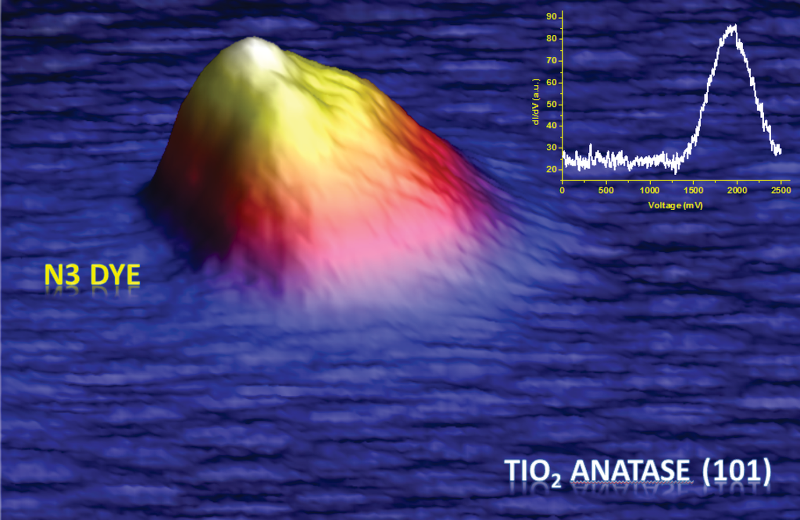
Dye-sensitized solar cells constitute a promising approach to sustainable and low-cost solar energy conversion. Our work provides for the first time atomic-scale insights into the relevant N3 dye - TiO2 anatase (101) interface revealing multi-conformational adsorption and energy level alignment of the photosensitizers as well as supramolecular interaction. Most importantly, the findings show that optimization strategies based solely on the electrochemical properties of the dye molecules should be replaced by a more comprehensive approach considering kinetic aspects in the dye-substrate coupling, possible strain in the molecular chromophore, and the atomic-scale structure of the dye−semiconductor interface.
Nano Lett. 14, 5563 (2014)
Article
Bio-inspired nanocatalysts for the oxygen reduction reaction
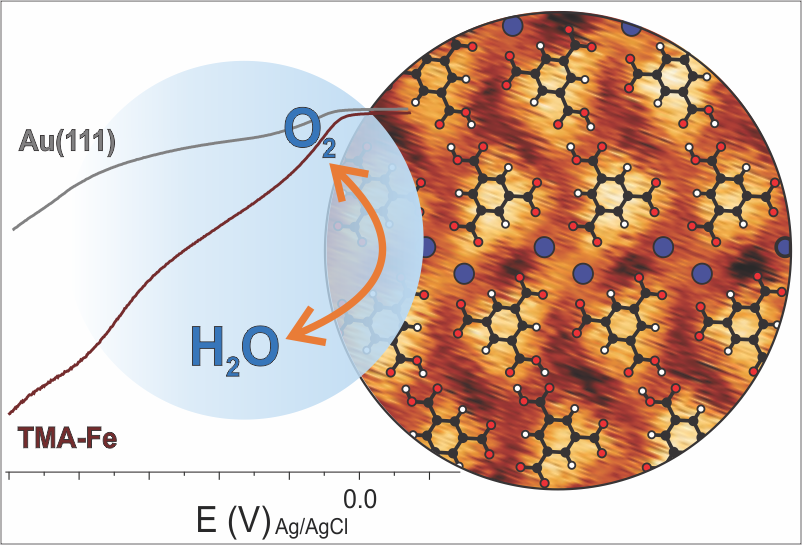
We show that bio-inspired catalytic metal centers can be effectively mimicked in two-dimensional metal-organic coordination networks self-assembled on electrode surfaces. Networks consisting of organic molecules coordinating to single iron and manganese atoms on Au(111) catalyze effectively the oxygen reduction and reveal distinctive catalytic activity in alkaline media. The results demonstrate the high potential of surface-engineered metal-organic networks for electrocatalytic conversions.
Nat. Commun. 4, 2904 (2013)
Article
Strong evidence for weak coupling Kondo Physics
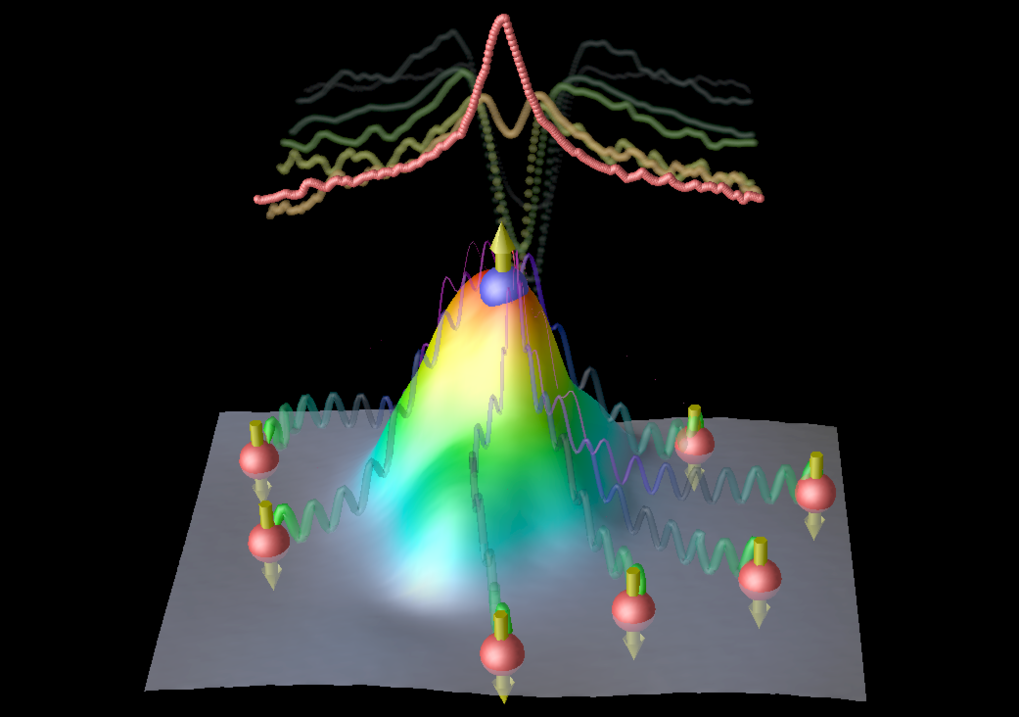
While many aspects in physics can be treated with single-particle models, many-body correlations are of great interest because only by taking them into account intriguing effects like superconductivity, heavy Fermion systems, and the Kondo effect can be explained. The Kondo effect arises due to the interaction between a localized spin and the electrons of a surrounding host and manifests itself as a characteristic zero bias anomaly in tunneling experiments. Studies of magnetic impurities by scanning tunneling spectroscopy have renewed interest in Kondo physics, however a quantitative comparison with theoretical predictions remained challenging. Here we show that both temperature and magnetic field dependence of the zero-bias anomaly detected on an organic radical molecule weakly coupled to a metal surface can be described with astonishing agreement by perturbation theory as originally developed by Jun Kondo 50 years ago. These results are not only a benchmark for predictions of theories for the Kondo effect itself but also for correlated electron materials in general.
Article
Record energy resolution in scanning tunneling spectroscopy
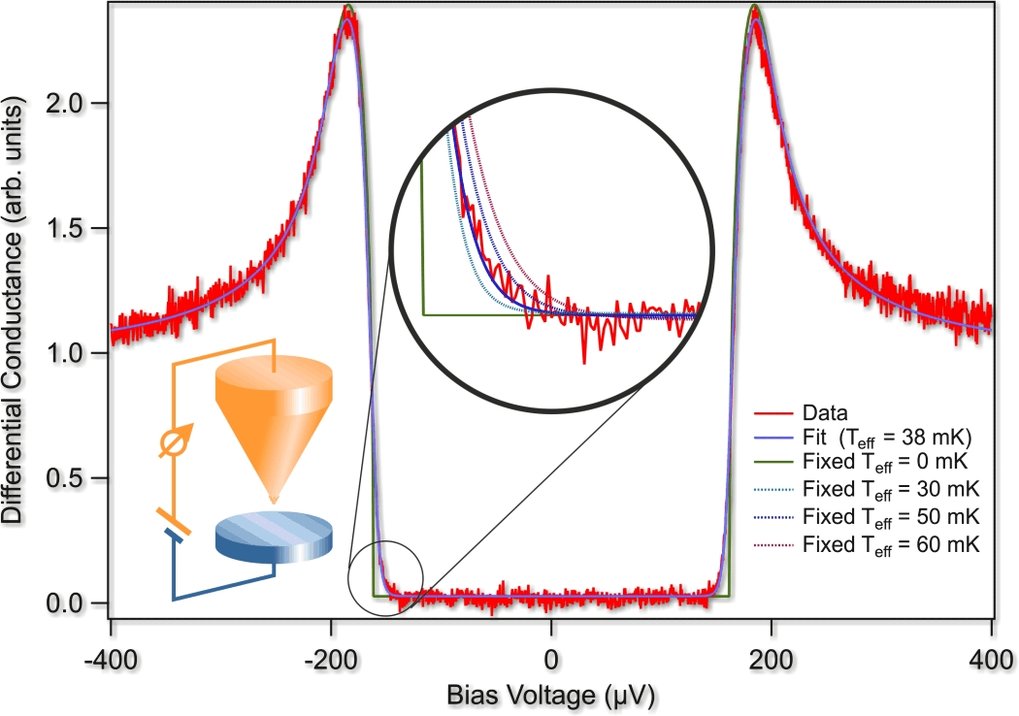
Progress in research is intimately connected with progress in developing novel and improved experimental methods. We have constructed a scanning tunneling microscope (STM) operating at a base temperature of 10 mK and in high magnetic fields up to 14 Tesla. It is combined with an ultra high vacuum preparation chamber allowing to study a large variety of samples and tips. Our mK-STM offers ultimate energy resolution combined with the atomic scale spatial resolution. The energy resolution of the setup, determined from an aluminum tip on a copper sample (see figure), is 11.4±0.3 µeV (Teff = 38±1 mK).
Rev. Sci. Instr. 84, 033903 (2013)
Article
Nature's richness manifested in topological insulators
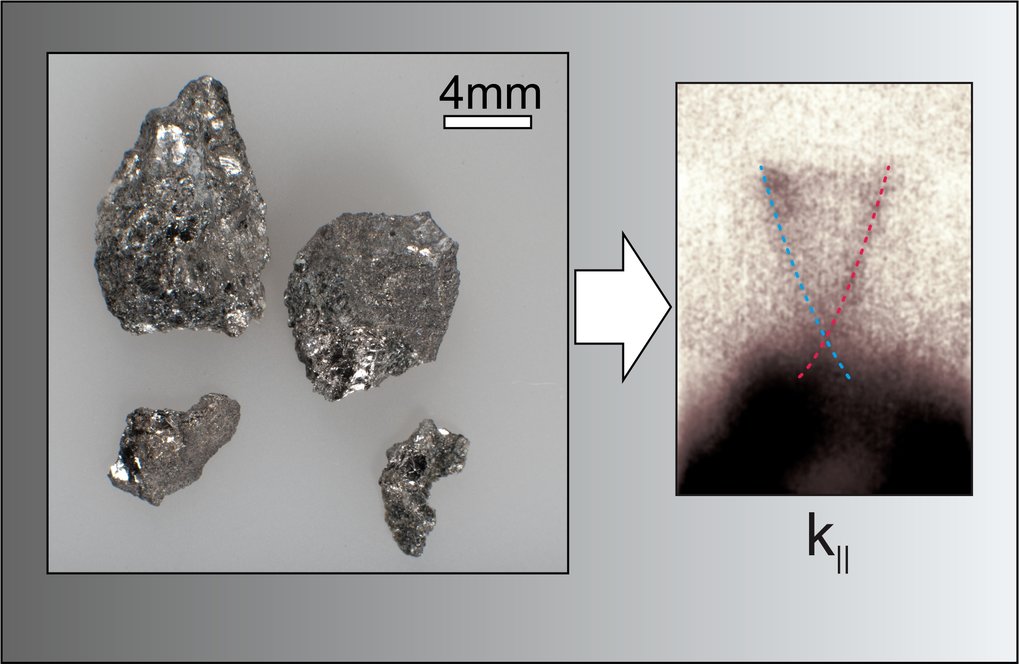
Nature is a rich source of technologically relevant materials, such as diamond, one of the hardest known materials, or graphite as a suitable precursor of graphene. This list has now gained a new member belonging to the new class of topological insulators (TIs). The surface states of TIs display a linear dispersion combined with spin polarization due to spin-momentum locking, which opens intriguing application perspectives in spintronics. We have found that the mineral Kawazulite with the general chemical composition Bi2(Te,Se)2(Se,S) is a natural TI whose electronic properties compete well with its synthetic counterparts. Based on this discovery, natural TIs may exist in other minerals, which due to their minimized defect densities display even better electronic characteristics.
Nano Letters 13, 1179 (2013)
Article
High mobility Bi2Te2Se Platelets on h-Boron Nitride
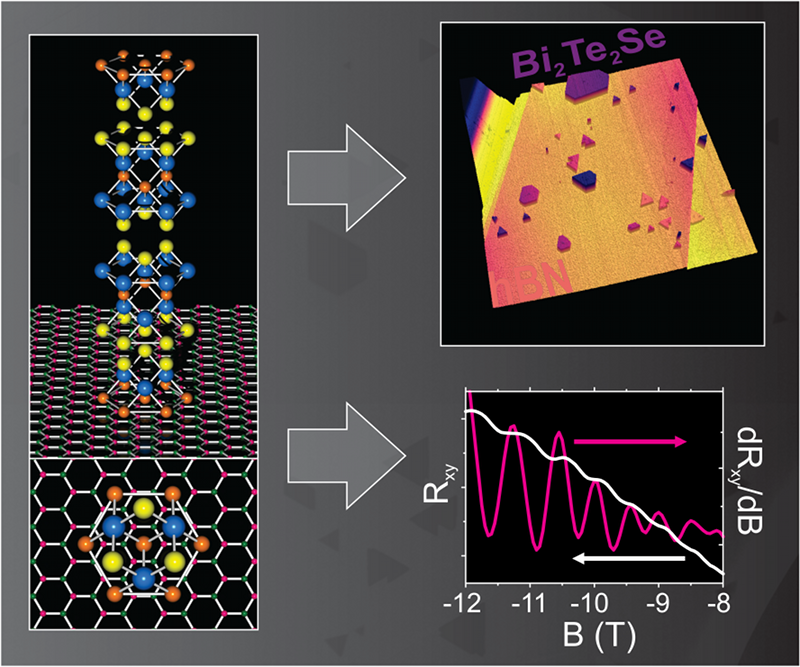
Topological insulators (TIs) are attracting increasing attention owing to their peculiar helical states at their boundaries. However, electrical detection of these states is complicated by the interference of bulk conduction that arises due to pronounced doping originating from lattice defects. We have demonstrated the growth of high quality nanoplatelets of the topological insulator Bi2Te2Se through van der Waals epitaxy on thin hexagonal boron nitride (hBN) substrates. In this manner, a significant increase of the surface state carrier mobility is achieved, thus opening the possibility to observe well-developed Shubnikov-de Haas oscillations in the platelets. Furthermore, the platelets' small thickness enables effective tuning of the Fermi level position with the aid of a back gate.
Nano Letters 12, 5137 (2012)
Article
Imaging of individual protein molecules at the single amino acid level
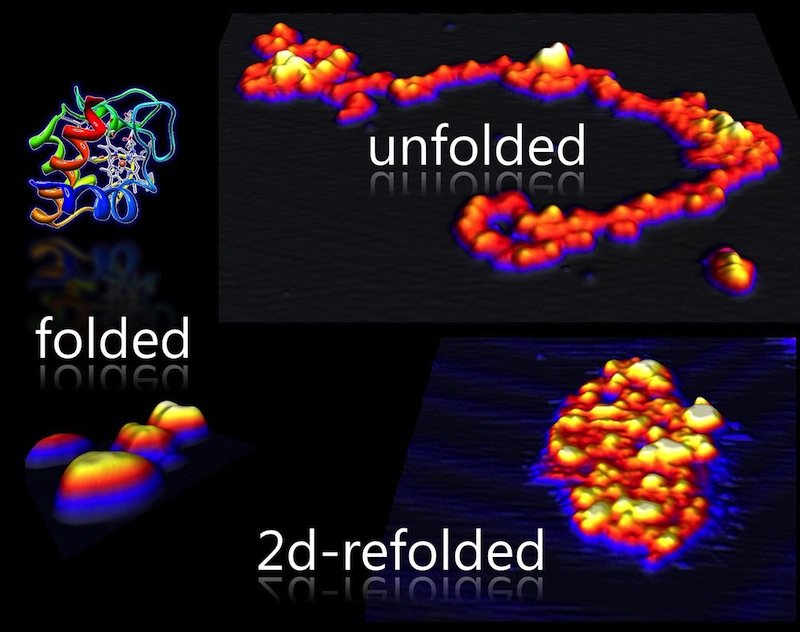
The folding of a polypeptide chain into a specific three-dimensional protein is probably the most fascinating example for the self-assembly of functional nanostructures. Using electrospray ion beam deposition (ES-IBD) of selectively folded and unfolded Cytochrome c protein ions on atomically defined solid surfaces in ultrahigh vacuum we demonstrated that it is possible to employ folding processes at the same level of complexity within a technological environment like the vacuum processing of surfaces. In this environment the unprecedented resolution of the scanning tunneling microscope allowed for the imaging of individual protein molecules at the single amino acid level. On the surface folded proteins are found to retain their three dimensional structure. Unfolded proteins are observed as extended polymer strands displaying submolecular features with resolution at the amino acid level. On weakly interacting surfaces unfolded proteins refold into flat, irregular patches composed of an individual molecule. This suggests the possibility of two-dimensionally confined folding of peptides of an appropriate sequence into regular two dimensional structures as new approach towards functional molecular surface coatings
Nano Letters 12, 2452 (2012)
Article
The Quantum Magnetism of Individual Manganese-12-Acetate Molecular Magnets Anchored at Surfaces
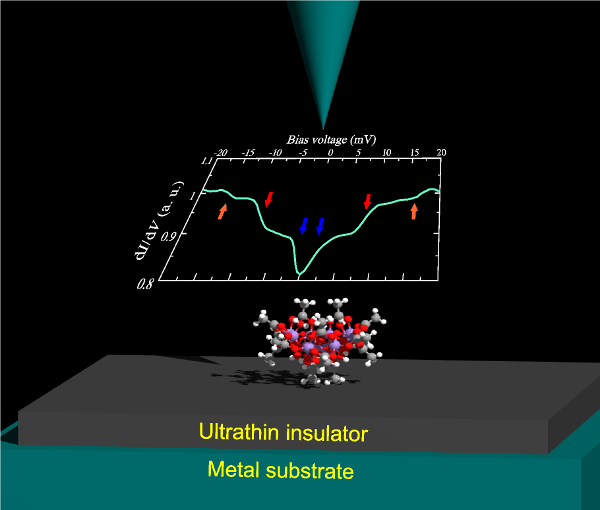
Single molecular magnets (SMM) inspire the research in information storage, spintronics, and quantum computation due to their magnetic properties which lie at the interface between classical and quantum mechanical description. Manganese-12-Acetate (Mn12) is the archetypical SMM due to its high spin and long spin relaxation time. While these properties have been observed on bulk samples, the deposition on surfaces has not yet been possible while retaining these characteristics. In our experiment we demonstrate the surface deposition of intact Mn12 molecules by electrospray ion beam deposition. Using a scanning tunneling microscope we detect directly the preserved magnetism as low-energy fingerprint in inelastic spin-flip spectroscopy. These results are supported by DFT based calculations and establish that individual Mn12 molecules retain their intrinsic quantum magnetism.
Nano Letters 12, 518 (2012)
Article
Archived Highlights
Quantum Point Contact Microscopy
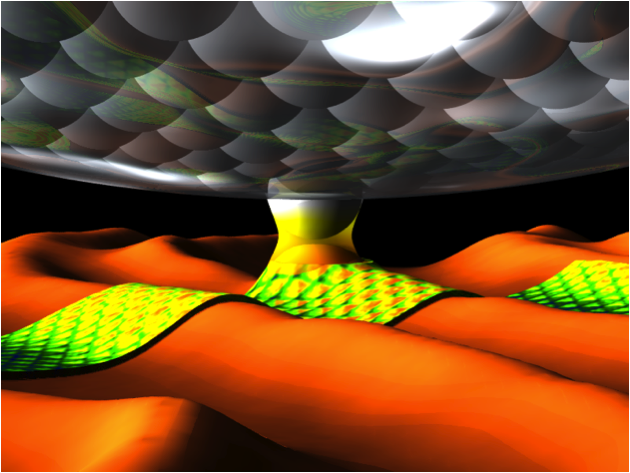
Instead of measuring the current through a tunneling gap, in Quantum Point Contact Microscopy we scan a single atom in contact with the tip and the surface across a metal surface. While scanning, the conductance is recorded. This technique yields surprisingly crisp and sharp images of the surface atomic structure. Since the scanned atom always stays in contact with the surface, the conductance yields beyond structural information also some chemical contrast – depending on the species which is underneath it.
Nano Lett. 11, 3838 (2011)
Article
Near-field dynamics of optical Yagi Uda nanoantennas
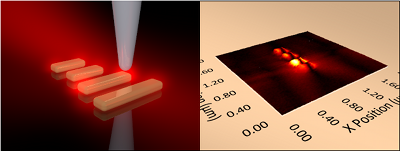
In analogy to radio antennas, optical Yagi-Uda antennas are directional receptors for light. Measuring optical amplitude and phase, cross-polarized apertureless SNOM reveals the near-field dynamics of antenna eigenmodes. Phase retardation effects between the antenna elements lead to a constructive field enhancement on the feed element when illuminating from the front. Interference is destructive for backward illumination, accounting for the directionality of the antenna.
Nat. Commun. 2, 267 (2011)
Nano Lett. 11, 2819 (2011)
Article
A tunable two impurity Kondo System
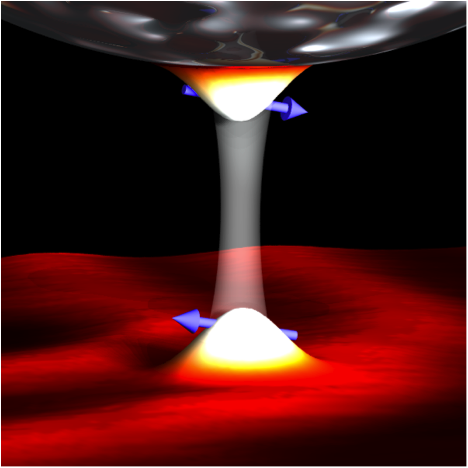
The physics between two magnetic impurities, which interact with each other is very rich and has been the object of numerous theoretical studies. While for weak interaction, the spin of the impurities is suppressed by scattering of conduction electrons, for strong interaction their magnetic properties emerge. In our experiment, we have studied this model system by attaching a cobalt atom to the tip of our STM. Bringing the atom on the tip close to a cobalt atom on the surface, we could tune their interaction continuously by varying the tip-sample distance – thus providing an ideal playground to compare theory and experiment.
Nat. Phys. 7, 901 (2011)
Article
Label-free detection of attomolar DNA
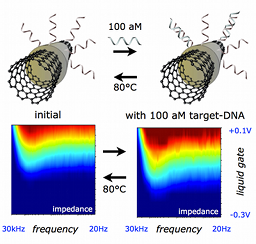
Detection of nucleic acid sequences is usually performed by Polymerase Chain Reaction (PCR)-based techniques that require amplification and labeling of the target sequence. Here we present a label-free direct detection technique able to detect as low as 2000 copies in a 30 microL sample droplet. The detection is based on the use of few carbon nanotubes as an active element. The transduction takes place through the electrochemical field-effect. In addition to detecting DNA at attomolar concentrations in test solutions the CNT-DNA-biosensors are able to distinguish ultralow concentrations of target DNA in a heterogeneous medium.
Angew. Chem. Int. Ed. 50, 3710 (2011)
Article
Observation of shell effects in superconducting nanoparticles of Sn

Quantum confinement dramatically modifies the properties of nanoscale systems. In small superconducting Sn nanoparticles, it has now been demonstrated by scanning tunneling microscopy that for well defined 'magic' sizes the quantum effects result in giant enhancements (up to 60%) of the superconducting energy gap. The research paves new ways towards the ultimate goal of room temperature superconductivity.
Nature Materials 9, 550 (2010)
Article
Enzyme-free carbon nanotube affinity sensor for the detection of sugars
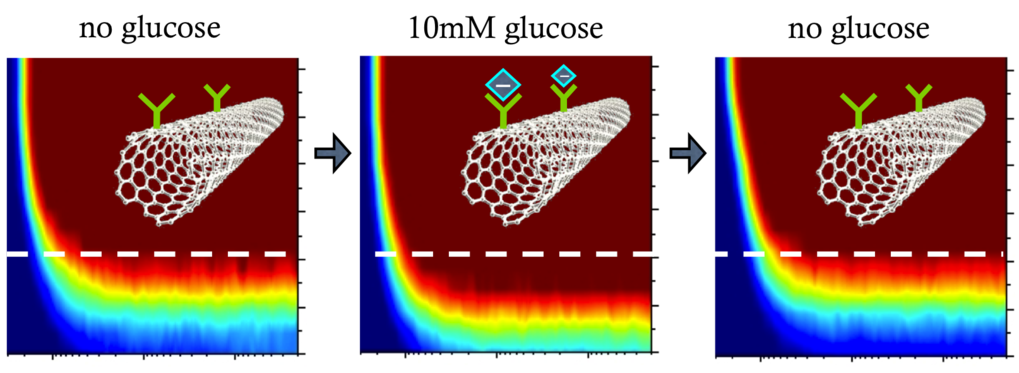
Sugars / carbohydrates are important markers for different diseases, the most important of them being glucose for diabetes. Enzymatic sensors are widespread for the detection of glucose in vitro. However, the limited stability of the immobilized enzyme may restrict the shelf life of such sensor systems and their application in in vivo glucose monitoring. Here, we have realized a sugar sensor using a synthetic receptor (namely boronic acid) that is coupled to carbon nanotubes in a controlled manner. The use of a unique combination of impedance spectroscopy and field-effect detection leads to a stable and reproducible sensor response. The detection is based on affinity of glucose to the attached receptor on the nanotube surface, which leads to reversible changes in the sensor characteristics. Such sensors are highly promising for lab-on-a-chip applications and point-of-care diagnostics.
Analytical Chemistry 82, 6090 (2010)
Article
Atomic resolution TEM of chemically derived graphene reveals a broad range of defective features
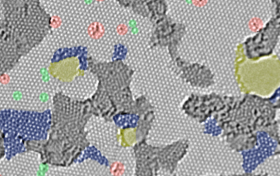
Despite significant recent progress in the chemical synthesis of graphene, the electrical conductivity of the obtained sheets still lacks behind that of exfoliated graphene by one order of magnitude. While it is clear that the electrical performance of the chemically derived graphene is limited by defects, their nature and distribution within the sheets has remained elusive so far. We have used high resolution transmission electron microscopy to identify the specific atomic scale features in monolayers derived from graphene oxide. The layers were found to comprise defect free graphene areas with sizes of a few nanometers interspersed with defect areas dominated by clustered pentagons and heptagons. Interestingly, the carbon atoms in these defect areas are bonded to three neighbors maintaining a planar sp2-configuration, which renders them undetectable by spectroscopic techniques. Moreover, these defects introduce significant in-plane distortions and strain in the surrounding lattice
Nano Letters 10, 1144 (2010)
Article
Charge transfer induced structural rearrangements at both sides of organic-metal interfaces

Electron transfer at the metal/organic interface can lead to substantial structural rearrangements on both the organic and metallic sides of the interface. These structural modifications mediate new intermolecular interactions through the creation of stress fields that could not have been predicted on the basis of gas-phase conformational data. Using scanning tunnelling microscopy, low-energy electron diffraction, X-ray photoemission spectroscopy, near-edge X-ray absorption fine structure spectroscopy and density functional theory calculations we demonstrate this effect for the organic electron acceptor TCNQ on a copper surface. Such charge transfer induced structural rearrangements at both sides of the organic/metal interface might have significant effects on the subsequent growth and structure of the organic film and, therefore, on device performance.
Nature Chemistry 2, 374 (2010)
Article
Potrait of the potential barrier at metal-organic nanocontacts

Electron transport through metal-molecule contacts greatly affects the operation and performance of electronic devices based on organic semiconductors and is at the heart of molecular electronics exploiting single molecule junctions. We use scanning tunnelling microscopy to probe directly the nanocontact between a single molecule and a metal electrode in unprecedented detail. Our experiments show a significant variation on the submolecular scale 1. The local barrier modulation across an isolated 4-[trans-2-(pyrid-4-yl-vinyl)] benzoic acid molecule bound to a copper(111) electrode exceeds 1 eV. The giant modulation reflects the interaction between specific molecular groups and the metal and illustrates the critical processes determining the interface potential. Guided by our results, we introduce a new scheme to locally manipulate the potential barrier of the molecular nanocontacts with atomic precision.
Nature Materials 9, 320 (2010)
Article
Supramolecular control of the magnetic anisotropy in two-dimensional high-spin Fe arrays at a metal interface
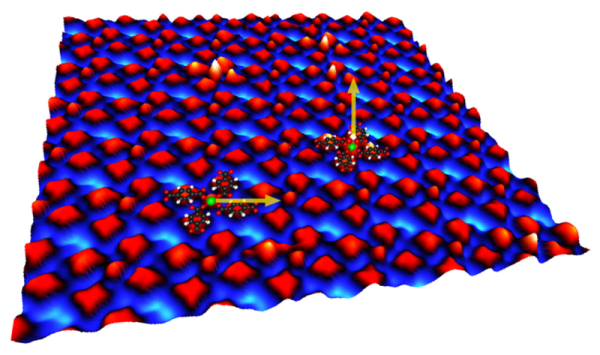
The control of magnetic anisotropy is a key issue the development of metal-organic materials for magnetic applications, both at the single molecule and extended film level. In so-called single molecule magnets, this is achieved by chemical modification of the environment and variations in the number of metal ions that carry the magnetic moment. We show that the supramolecular assembly of Fe and 1,4-benzenedicarboxylic acid molecules on a Cu surface results in ordered arrays of high-spin mononuclear Fe centers on a 1.5 nm square grid. Lateral coordination with the molecular ligands yields unsaturated yet stable coordination bonds, which allow for the chemical modification of the electronic and magnetic properties of the Fe atoms independently from the substrate. The easy magnetization direction of the Fe centers can be switched by oxygen adsorption.
Nature Mater. 8, 189 (2009)
Article
Atomically thin Iron-Platinum layer with extraordinary stable magnetic properties
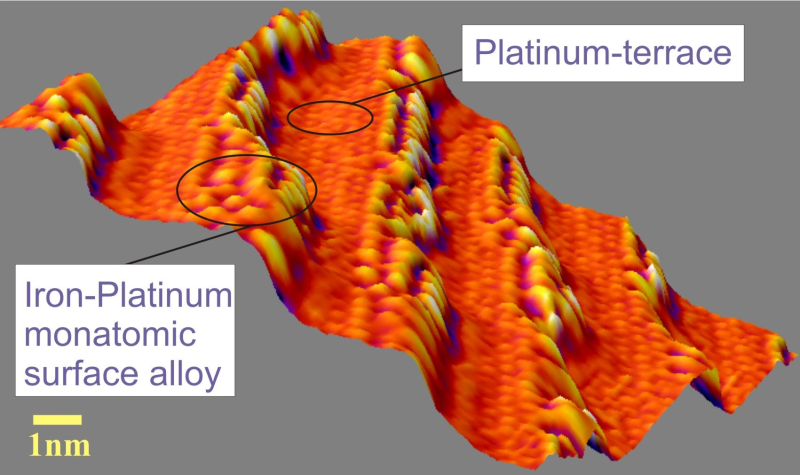
It has been a long time fundamental question how far a magnets dimension can be reduced without encountering a loss of order in the magnetization state. For the case of carefully designed Iron-Platinum mixtures the mechanism for a rigid magnetisation orientation work down to the extreme limit of a 2-dimensional, atomically thin monolayer. A key ingredient for the rigidity in the magnetic properties is the large spin-orbit coupling constant of Platinum which causes the Iron-Platinum mixture to orient its magnetization perpendicular to the monolayer. The results are of special interest regarding future magnetic applications in the field of nanotechnology.
Phys. Rev. Lett. 102, 067207 (2009)
Article
Plasmonic nanowires act as one-dimensional Fabry Perot resonators
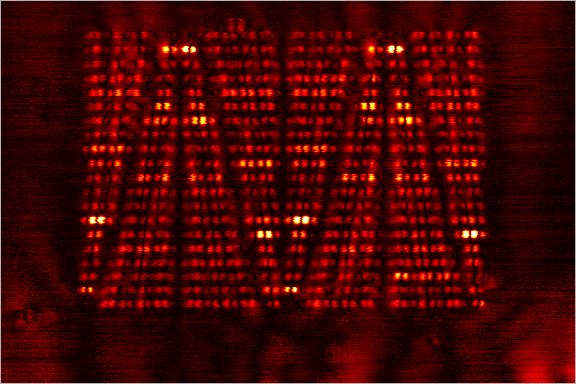
Thin metal nanowires support quasi 1-dimensional plasmonic resonances, which we study by nearfield optical microscopy and simulation. Based on an analogy to Fabry-Pérot-like cavity modes, a successful description is found that allows to measure important mode parameters like propagation and damping constant, as well as the reflection phase at wire ends with superb accuracy. Besides the usually dominant odd-order resonances, even order resonances are shown to be accessible under symmetry-breaking illumination conditions.
Nano Lett. 9, 2372 (2009)
Article
Enabling a close look at nanoparticles
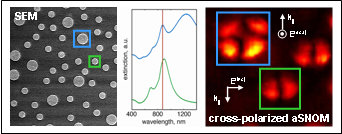
We pave the road to faithful real space mapping of optical near-fields components associated with surface plasmon polariton (SPP) resonances. Our technique basically eliminates the hitherto forbiddingly strong coupling effects between sample and probe. The key aspect are orthogonal polarization states of the exciting and collected radiation in our apertureless scanning near-field optical microscope (aSNOM). Recorded images of dipolar and quadrupolar SPPs in gold nanodisks compare excellently to numerical simulations of the bare samples.
Nano Lett. 8, 3155 (2008)
Article
Quasiparticle chirality in epitaxial graphene probed at the nanometer scale
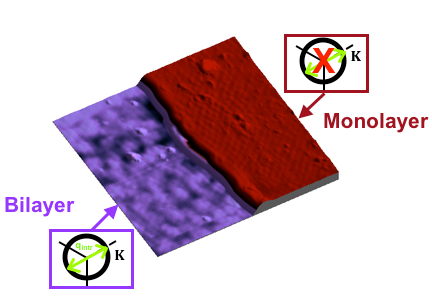
The tremendous scientific interest in graphene derives from its unconventional electronic properties; these properties stem from a particular feature of graphene’s quasiparticles, the so-called chirality. Here we report that scanning tunneling microscopy can be used to determine this unique property. The quasiparticle chirality is reflected in the quantum interference pattern associated with intravalley backscattering off impurities and can be directly read from its fast Fourier transform. Our results show that the quasiparticles in epitaxial graphene on SiC(0001) have the chirality expected for ideal graphene.
Phys. Rev. Lett. 101, 206802 (2008)
Article
Scanning photocurrent microscopy reveals doping at metal contacts on graphene

While it is well-established that surface adsorbates have a profound influence on the electrical properties of graphene, much less is known about the role of the electrical contacts in such devices. We have used scanning photocurrent microscopy to probe the electronic properties of graphene in close proximity to gold and titanium contacts on top of a graphene sheet. The photocurrent images reveal the presence of potential steps at the contacts, whose sign depends on the magnitude of the metal work function with respect to the value of graphene. This local doping of the sheet by the metal contacts provides a straightforward explanation for various phenomena in graphene-based devices, such as the asymmetry observed in the conductance vs. gate voltage characteristics.
Nature Nanotechnology 3, 486 (2008)
Article
Graphene oxide as a convenient precursor of extended graphene sheets
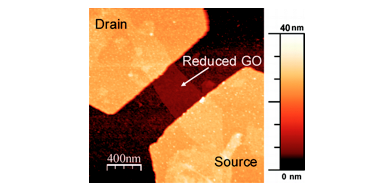
The pioneering mechanical exfoliation approach to graphene provides high quality monolayers, however, only in a very low yield. Hence, up-scalable production methods for graphene are needed. We have explored a chemical synthesis route, involving the chemical reduction of graphene oxide sheets that can easily be obtained in large amounts. Thus obtained graphene monolayers were found to display electrical conductivities of up to 2 S/cm at room temperature. Temperature-dependent electrical measurements and Raman spectroscopic investigations indicate that charge transport occurs via variable range hopping between intact graphene islands with sizes on the order of several nanometers. These features render chemically derived graphene into a useful material for various applications such as transparent conducting electrodes or chemical sensors.
Nano Letters 7, 3499 (2007)
Article
Self-recognition and Self-selection in multicomponent supramolecular coordination networks on surfaces
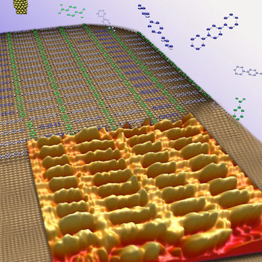
The automatic molecular assembly and selection steps exhibited by the molecules, which start as random mixtures, demonstrates a fundamental step in the evolution of life. The organization is activated by instructions which are built-in to the molecules. During assembly, molecules exhibit active selection: those in incorrect positions move to make room for others which fit properly. The molecular-level observation of such self-selection gives, for the first time, direct insight into fundamental steps of the biological evolution from inanimate molecules to living entities. The resulting nanostructures also hold great promise as an efficient avenue to new catalysts, nanotechnologies, and surface applications.
Proceedings of the National Academy of Sciences USA 104, 17927 (2007)
Article
Tracking the chiral recognition of adsorbed dipeptides at the single molecule level

A human body has more than 10 to the power of 27 molecules with about one hundred thousand different shapes and functions. Interactions between molecules determine our structure and keep us alive. We have followed the interaction of only two individual molecules to show the basic mechanism underlying recognition of dipeptides. By means of scanning tunnelling microscopy movies and theoretical simulations they have shown how dynamic interactions induce the molecular fit needed for the transfer of structural information to higher levels of complexity. This dynamic picture illustrates how recognition works at the very first steps, tracking back the path in the evolution of complex matter.
Angewante Chemie Intl. Ed. 46, 4492 (2007)
Article
Subtle interactions between single spins
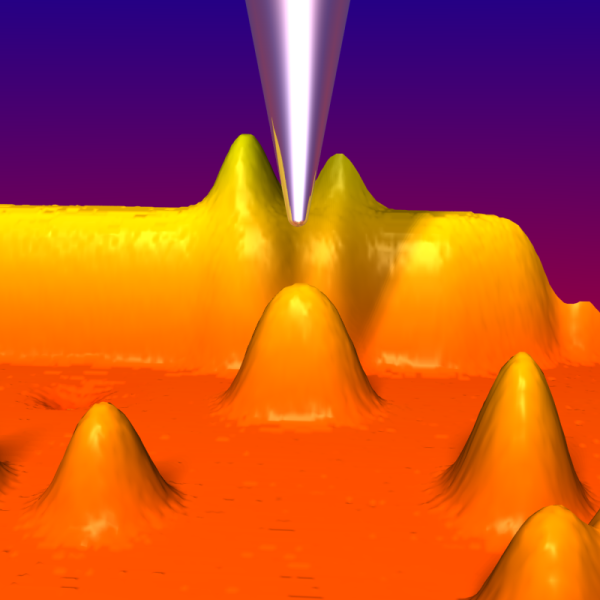
Using a scanning tunneling microscope, the interaction of the spins of two neighboring cobalt atoms adsorbed at a copper surface has been measured as a function of their distance with atomic precision. As a probe for the magnetic interactions, we have exploited the Kondo effect. This effect is due to the interaction of the spin of a magnetic adatom with the electrons of the metallic substrate. It can (at low temperatures) be detected by the scanning tunneling microscope as resonance in the local electronic density of states. By a detailed analysis of the dependence of the Kondo resonance on the distance between two adjacent cobalt adatoms on a copper surface, the researchers were able to probe their magnetic interactions.
Phys. Rev. Lett. 98, 056601 (2007)
Article
Giant Spin-splitting through surface alloying
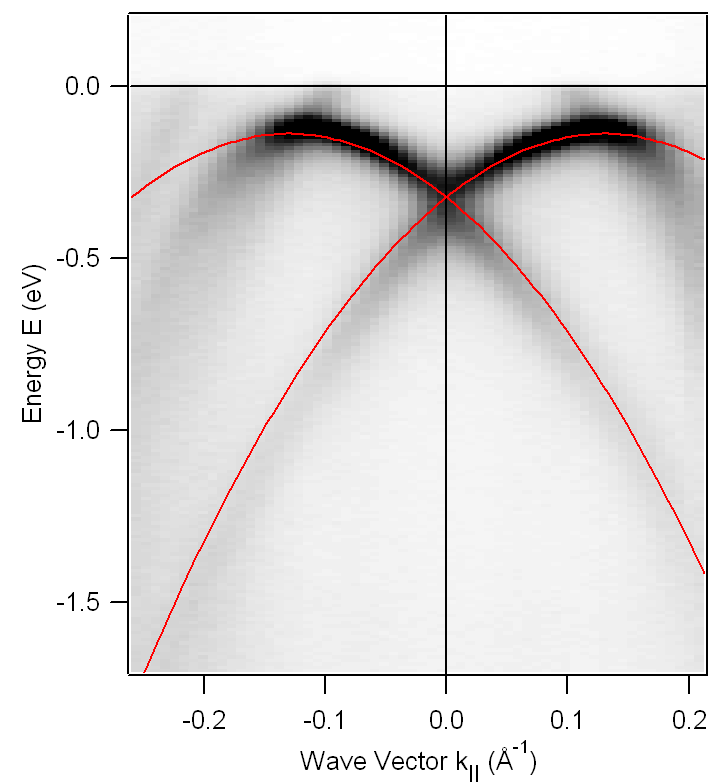
The broken inversion symmetry at surfaces allows the spin-orbit interaction to lift the spin degeneracy resulting in a very characteristic band dispersion known as the Rashba effect. The structural change on the silver (111)-surface induced by the surface alloy formation of sub-monolayer amounts of bismuth atoms yields a spin-split band structure that is one of the largest spin-splittings ever observed. In this system the spin-orbit interaction itself cannot account for the size of the spin-splitting so that the origin of the spin-splitting mechanism has to be sought in the structure itself: an aspect of the spin-splitting mechanism that so far has been underestimated.
Phys. Rev. Lett. 98, 186807 (2007)
Article
|